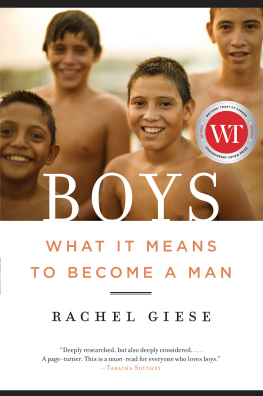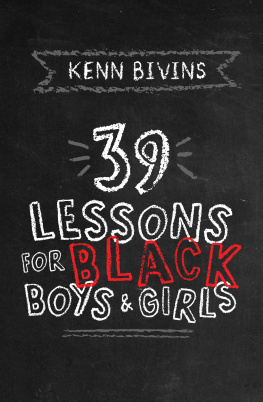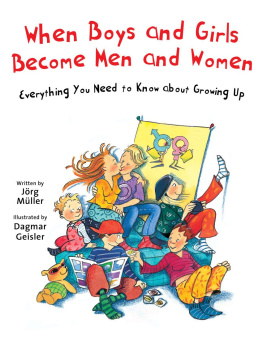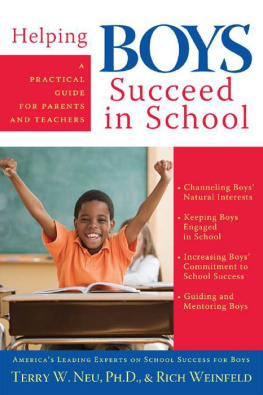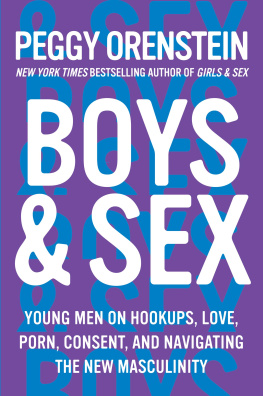Thank you for downloading this Simon & Schuster eBook.
Join our mailing list and get updates on new releases, deals, bonus content and other great books from Simon & Schuster.
C LICK H ERE T O S IGN U P
or visit us online to sign up at
eBookNews.SimonandSchuster.com
We hope you enjoyed reading this Simon & Schuster eBook.
Join our mailing list and get updates on new releases, deals, bonus content and other great books from Simon & Schuster.
C LICK H ERE T O S IGN U P
or visit us online to sign up at
eBookNews.SimonandSchuster.com
Also by Christina Hoff Sommers
One Nation Under Therapy: How the Helping Culture Is Eroding Self-Reliance
Who Stole Feminism? How Women Have Betrayed Women

Simon & Schuster
A Division of Simon & Schuster, Inc.
1230 Avenue of the Americas
New York, NY 10020
www.SimonandSchuster.com
Copyright 2000, 2013 by Christina Hoff Sommers
Preface copyright 2013 by Christina Hoff Sommers
All rights reserved, including the right to reproduce this book or portions thereof in any form whatsoever. For information address Simon & Schuster Subsidiary Rights Department, 1230 Avenue of the Americas, New York, NY 10020.
This Simon & Schuster hardcover edition August 2013
SIMON & SCHUSTER and colophon are registered trademarks of Simon & Schuster, Inc.
The Simon & Schuster Speakers Bureau can bring authors to your live event. For more information or to book an event contact the Simon & Schuster Speakers Bureau at 1-866-248-3049 or visit our website at www.simonspeakers.com.
Designed by Aline C. Pace
Jacket design by Laurie Carkeet
Jacket photograph Catherine Lender/Getty Images
Library of Congress Cataloging-in-Publication Data
Sommers, Christina Hoff.
The war against boys: how misguided policies are harming our young men / Christina Hoff Sommers.New and Revised Edition.
pages cm
Includes bibliographical references and index.
1. Teenage boysUnited States. 2. Teenage boysUnited StatesPsychology. 3. FeminismUnited States. I. Title.
HQ797.S6 2013
305.2351dc23
2012051639
ISBN 978-1-4516-4418-0
ISBN 978-1-4391-2658-5(ebook)
For Tamler and David Sommers
Contents
Preface to the New Edition
W hen the first edition of The War Against Boys appeared in 2000, almost no one was talking about boys educational and social problems. Now its hard to open a newspaper without stumbling upon references to the multiple books, articles, studies, and documentaries highlighting boys academic, social, and vocational deficits. So is the war over? Not yet.
Although many educators recognize that boys have fallen far behind girls in school, few address the problem in a serious way. Schools that try to stop the trend, through boy-friendly pedagogy, literacy interventions, vocational training, or same-sex classes, are often thwarted. Womens lobbying groups still call such projects evidence of a backlash against girls achievements and believe they are part of a campaign to slow further female progress.
The recent advances of girls and young women in school, sports, and vocational opportunities are cause for deep satisfaction. They should not, however, blind us to the large and growing cohort of poorly educated young men in our midst, boys who are going to be lost in our knowledge-based economy. To address the problem, we must acknowledge the plain truth: boys and girls are different. Yet in many educational and government circles, it remains taboo to broach the topic of sex differences. Gender scholars and experts still insist that the sexes are the same and argue that any talk of difference only encourages sexism and stereotypes. In the current environment, to speak of difference invites opprobrium, and to speak of boys special needs invites passionate, organized opposition. Meanwhile, one gender difference refuses to go away: boys are languishing academically, while girls are soaring.
In the first edition of The War Against Boys , I focused primarily on how groups such as the American Association of University Women, the Wellesley Centers for Women, and the Ms. Foundation were harming our nations young men. These organizations and their doctrines are still very much with us. But in this revised edition, I describe the emergence of additional boy-averse trends: the decline of recess, punitive zero-tolerance policies, myths about juvenile superpredators, and a misguided campaign against single-sex schooling. As our schools become more feelings centered, risk averse, competition-free, and sedentary, they move further and further from the characteristic sensibilities of boys.
However, in the fourteen years since The War Against Boys was first published, England, Australia, and Canada have made concerted efforts to address the boy gap. In these countries, the public, the government, and the education establishment have become keenly aware of the increasing number of underachieving young males. In stark contrast to the United States, they are energetically, even desperately, looking for ways to help boys achieve parity. They have dozens of commissions, trusts, and working groups devoted to improving the educational prospects of boys. Using evidence and not ideology as their guide, these education leaders speak openly of male/female differences and dont hesitate to recommend sex-specific solutions.
Success for Boys, for example, is an Australian program that has provided grants to 1,600 schools to help them incorporate boy-effective methods into their daily practice. In the United States, our education establishment remains paralyzed with its head in the sand.
The subtitle of the first edition was How Misguided Feminism Is Harming Our Young Men. The emphasis on misguided I did not intend to indict the historical feminist movement, which I have always seen as one of the great triumphs of our democracy. But some readers took the book to be an attack on feminism itself, and my message was lost on them. In this edition, I have sought to make a clearer distinction between the humane and progressive womens movement and todays feminist lobby. That lobby too often acts as a narrow, take-no-prisoners special interest group. Its members see the world as a zero-sum struggle between women and men. Their job is to side with the womenbeginning with girls in the formative years of childhood.
Most women, including most equality-minded women, do not see the world as a Manichean struggle between Venus and Mars. The current plight of boys and young men is, in fact, a womens issue. Those boys are our sons; they are the people with whom our daughters will build a future. If our boys are in trouble, so are we all.
In the war against boys, as in all wars, the first casualty is truth. In this updated edition, I give readers the best and most recent information on where the boys are. I say who is warring against them and why; I describe the best scientific research on the issues in debate; and I show readers the high price we will pay if we continue to neglect academic and social needs of boys. I also suggest solutions.
This book explains how it became fashionable to pathologize the behavior of millions of healthy male children. We have turned against boys and forgotten a simple truth: the energy, competitiveness, and corporal daring of normal males are responsible for much of what is right in the world. No one denies that boys aggressive tendencies must be mitigated and channeled toward constructive ends. Boys need (and crave) discipline, respect, and moral guidance. Boys need love and tolerant understanding. But being a boy is not a social disease.



